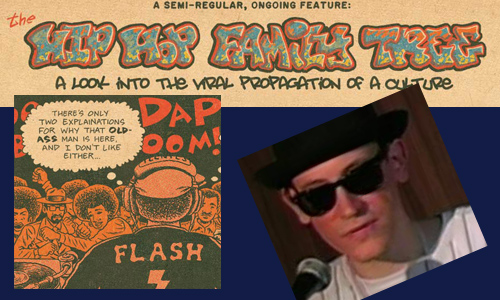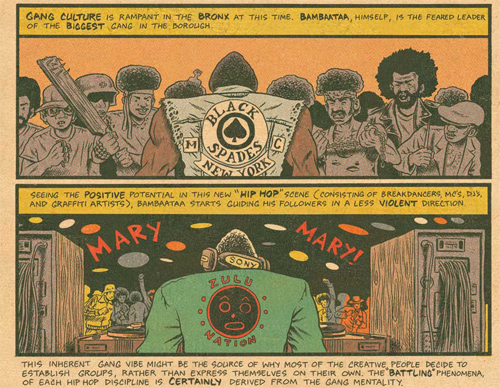
Efterhånden som internetlandet har udviklet sig til, at det ikke længere handler om midler men ideer for blive et hit, har do-it-yourself befolkningen fået hver deres lille niche. Der er fora for folk der hader ost, der er gossipbloggere, der finder på syrlige ordspil om de kendtes spiseforstyrrelser, og så er der Ed Piskor, der har sat sig for at kortlægge hiphoppens stamtræ – i tegneserieform.
Jeg opdagede ”The Hip Hop Family Tree” ved et tilfælde via Twitter, da det blev nævnt at nogen var begyndt at poste ensides comics om old school hiphop, og det viste sig at være noget så esoterisk som en præcis beskrivelse af historien bag Spoonie Gee’s første single gengivet som en Marvel eller DC Comics tegneserie. Da jeg dykkede ned i bagkataloget (der kommer cirka en ny episode om ugen) er det stille og roligt ved at udvikle sig til en kaleidoskopisk historiebog, hvor Afrika Bambaataa’s hærdebrede skuldre står side om side med Grand Master Flash’s atletiske armbevægelser i en tid hvor Run og DMC stadig er pattebørn i old schoolens slipstrøm.
Det der gør Ed Piskors arbejde så interessant er, at han for første gang sætter billeder på den del af hiphop-historien, der indtil nu kun har været mundtligt overleveret. Jo, vi har masser af fantastiske fotografier og videooptagelser fra 70’ernes Bronx takket være Martha Cooper, Henry Chalfant og Charlie Ahearn, der er blevet gengivet så ofte det nærmer sig ikonisering. Men hvordan det præcis så ud, da Furious Five brugte deres første løncheck på motorcross-cykler, eller da Kurtis Blow og Russell Simmons tog til Frankrig fik madforgiftning og blev bestjålet af de lokale groupies har man kun kunnet danne mentale billeder af. Desuden formår han at gøre figurerne levende og give dem deres egne små særegne træk, som Russell Simmons heftige talefejl og Big Bank Hanks godmodige Gårdmand Bjørn-attitude. Det er helt reel edutainment så det basker.
Jeg var så heldig at få Ed Piskor selv til at svare på en stribe spørgsmål om striberne. Eftersom de fleste læsere taler engelsk flydende, får I her originalversionen serveret. Så slipper jeg også for at skrive hiphop i stedet for Hip Hop hele tiden :-)
How did you get into Hip Hop and drawing?
I am from a very ghetto, shitty town, and my parents couldn’t afford much more than pencils and paper for my recreation as a boy. Throughout the town there were always little street corner cyphers with guys beatboxing and other dudes rhyming. The drug dealers in our city were emulating rappers I was seeing on MTV, like Rakim and Slick Rick. So Hip Hop and drawing were always as natural to me as anything else.
How did you get the idea for the Hip Hop Family Tree comic?
I’ve been wanting to do a comic based in old hip hop culture for a very long time, but, I couldn’t think of the approach I wanted to take. Sometimes the best ideas are staring you in the face and are completely logical, but, you overthink things. All of the sudden one day I just decided to lay out the history of rap music in the most comprehensive way I could, and here we are.

The style is almost like an old school Archie-comic, what was the inspiration for that look?
I wanted the project to look like it could have been ripped out of time. The story takes place, starting in the late 1970’s. I’m telling the tale in real time, you won’t see many retrospective panels, every panel is happening right now. The way I want the story to function is like it could have been an unearthed comic book from 35 years ago.
For a culture where one of the elements is graffiti, Hip-Hop has spawned surprisingly few comics. Why do you think that is, and were you still able to find any to be inspired by?
I like the work of Jim Mahfood, who is probably the first person to come to mind when I think of Hip Hop and comics. A big inspiration for the project was my very good friend Jim Rugg, who did a short piece for VH1 using an old comic style to showcase a rap battle between Grandmaster Caz and Bambaataa.
I know it might be touchy to reveal the sources of the info, kind of like a producer having to clear samples, but I assume you didn’t grow up in the 70’s Bronx, so how do you know so much about the history of old school Hip-Hop?
I’m very obsessed with Hip Hop and I’ve studied, and read, and consumed as many records, books, documentaries, and interviews on the subject as possible. I promise there’s not another cartoonist out there who can even come close to battling me in terms of knowledge of Hip Hop. So with that in mind, I felt like I might as well tell this story, since, no other cartoonists can. I honestly would much rather be a reader and a fan of the comic rather than doing it though, in a way. It’s a lot of hard work.
What do you do when the stories about the events differ? For instance I’ve heard at least three different stories about how The Furious Five and Crash Crew decided who could use the Freedom Break, so would you decide which pioneer is the most credible or draw several versions?
When it comes to certain things like that. I try to frame the strips to tell the story from the perspective of the dominant history. Most people would agree that Caz wrote all the Big Bank Hank lyrics, but, Hank says they both wrote collaboratively. I went with Caz on that one, clearly.

From Russell Simmons’ bug-eyed lisp to Afrika Bambaataa’s giant-like frame, is there a character you enjoy drawing more than others?
You’ve nailed the 2 I’m fondest of right now. I can’t wait to start drawing Pharoah, Bambaataa, Run DMC, Slick Rick, LL Cool J, and a bunch more soon though.
The stories as I read them are about friendship, entrepreneurship and creativity, but often the 80’s and onwards weren’t too nice a time the original pack of Hip-Hoppers, how do you view the progression of the culture?
Money corrupts. Plain and simple. The main subject of the story is rap music, and all the characters involved are just the nuts and bolts to keep the story moving forward. I’m not going to shy away from terrible things that may have occurred but, the drama isn’t going to be the major focus of the work.
How far up in history do you plan to take it, is there a cut-off line for you where old school becomes new school?
I’d like to take the story up to about where Biggie Smalls dies. My favorite year in Hip Hop is probably 1992, but the death of the last great emcee seems as good a place as any to stop the madness. It’s going to take a telephone book amount of pages to get there though.
Can you reveal some of the upcoming strips for us? Can we look forward to the Kool Moe Dee vs Busy Bee battle?
The Kool Moe Dee vs. Busy Bee battle will definitely be a coming highlight. We’ll be getting into Grandmaster Flash’s transition to Sugarhill records where they started dressing like the village people. We’ll reveal that their most famous song, The Message, was completely constructed by sources outside of Flash and the Furious Five. The formation of Run DMC. A young Rick Rubin goes to NYU. A young hardcore band of whiteboys start to visit Manhattan clubs where Hip Hop
performers rule.
There’s a lot to uncover and discover.
Den nemmeste måde at læse op på “The Hip Hop Family Tree” er ved at besøge Brainrot blogarkivet på Boingboing.net. Husk også at sige yo til Ed Piskor på Twitter.

Tak Peter. Dæleme det bedste set længe.
Du for sej!
Very interesting tale duloxetine lowest price C DRUG ELIGIBLE FOR 100 DAY MAINT QUANTITY 43